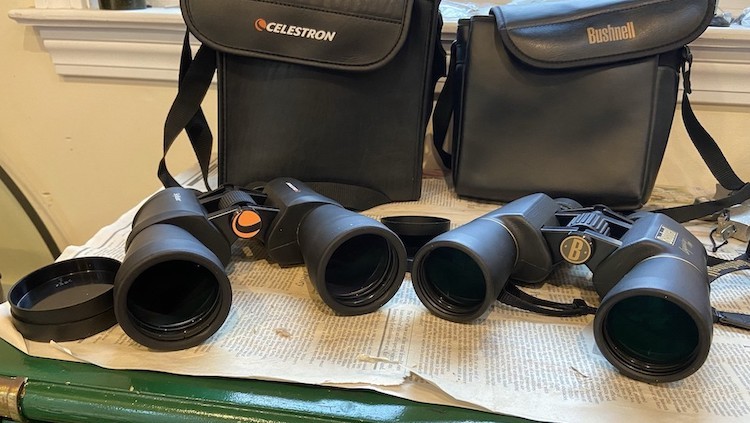$100-$175 Range
The prisms on the Legacy WP 10x50s are BAK-4 glass, which means a sharper, brighter field compared to BK-7. They are still very slightly undersized/noncircular and vignette about 5% of the aperture, which is in effect invisible. As is stated in the name, the Legacy WP 10x50s are fully waterproof and, I think, somewhat fogging-resistant—a nice bonus. All glass surfaces in the binoculars are also fully multi-coated for maximum light transmission.
The Legacy WP 10x50s have a field of view of 6.5 degrees, and given the 10x magnification, this means the apparent field is a nice, wide 65 degrees. The eyepieces have 20 mm of eye relief if you wear glasses for astigmatism (you don’t need them otherwise) and twist-up eyecups, as well as eyepiece caps that stay attached to the neck strap.
Downsides? Well, for one, the magnification. The 10x binoculars are really the limit for handheld use, and the weight of the Legacy WP 10x50s doesn’t help with steadying them. Children and some adults will have trouble holding them steady for long periods.
If you can hold them steady, the Bushnell Legacy WP 10x50s are great binoculars for stargazing. Mine has traveled with me halfway around the globe to dark locations and is great for daytime spotting too.


I am not sure if I’m getting binoculars or a telescope, as I am a beginner. I understande the advantages of binoculars, but what can we see with it? The moon and some blue or red spots, those being planets?
My goal is to see the moon and planets, at least up to Mars. Am I right to think I should get a telescope?
Thanks!
Perfect question, @Olivier. I was wondering the same thing while I was researching telescopes for beginners. This site has been beneficial.
Hi Oliver,
Buy a pair of £80 binoculars. Learn the night sky, the Constellations and find the brighter deep space objects. You can find and observe at least 50 Messier with Binoculars. While you are doing this you can save for a really good Telescope, and when you at last get it you won’t be a novice stumbling around in the dark you will be an Astronomer advancing in your hobby
Whatever your decision l hope you enjoy your new hobby for many to come.
Best wishes as always.
Good site and reviews. Good to see that the one I had in mind as a first time buyer looking to view stars and planets is the Celestron Cometron 7×50 though my question is should I get the Celestron 71257 UpClose G2 10 x 50 which are around the same price. Seems that the reviews are better for the first which is surprising since 10X magnification I would have thought would be slightly better if the price is around the same? Perhaps my lack of knowledge on these means somehow the 7X50’s are better quality for another reason? Much appreciate!
The 7x50s are easier to hold.
Great Site! Thanks for all the info and education. As a know-nothing senior looking to help nurture an adult daughter’s interest in star-gazing the heavens, your reviews & tips have been most valuable.
Do your by chance have any info / experience with either the Nikon Prostaff 5 : 8×42 OR the Bresser Pirsch Compact 10x34mm? I don’t know if one of these would be good for astronomical viewing or if they are more for land / daytime viewing.
Thanks again!
I would get the Prostaff, the Bressers are too small.
I own the Nikon Prostaff 7s 8×42 WP and absolutely love them for sky watching at night. The phase-corrected-coated roof prisms make a difference at night imho. Details on the Moon just pop along he terminator and I was able to easily detect the four largest moons around Jupiter and do it comfortably for long periods thanks to their light weight. These binoculars also work great for birding too. Btw love the site!
If we ignore the weight and size factor, are the Celestron Sky Master 25×100 a good choice for sky watching/astronomical viewing? My reasons for this choice are its size in terms of ease of storage and transport. I have limited storage room in my home and I have a small trunk Miata. So I would be either using on my upper deck, or travelling to a tall local hill. I already have a very sturdy tripod with a counter balance. The Dobsonian versions I’ve seen, are too large to transport and store. I do not require any computer controls or positioning systems. So with these factors in mind I thought of the Celestron Sky Master 25×100 might be a good choice. Your advice and guidance is very much appreciated and any suggested alternatives are most welcome.